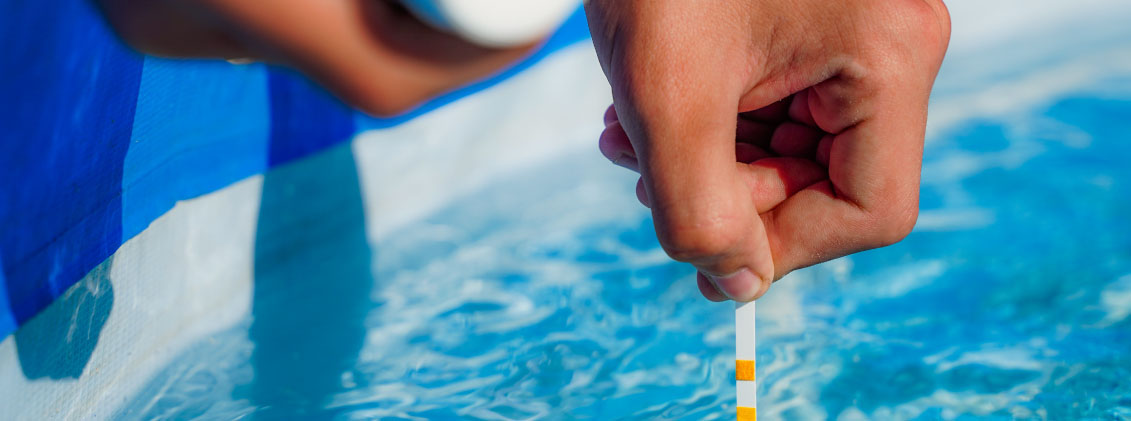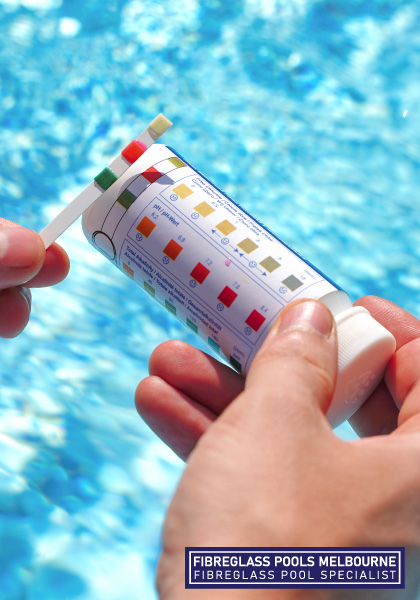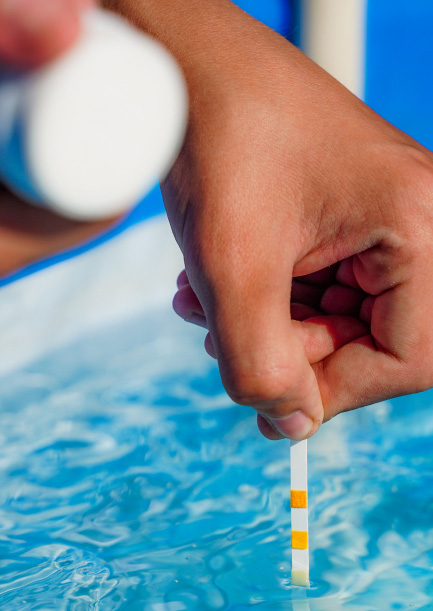A Beginners Guide To Testing Your Pool Water
As a pool owner, you may have heard about testing your pool's waters. When it comes to caring for maintaining your swimming pool, testing your pool's water can be essential. Testing the waters doesn't mean a visual inspection of your pool's waters, or testing the temperature either. You'll need the help of water test kits, as well as digital readers, to accurately measure the water balance of the pool.

Why Should You Test The Pool's Waters?
Unless the water in your fibreglass pool is clean, swimming in it isn’t such a good idea. If you have bacteria, or too many chloramines in the pool, for example, then this could affect the water health of the pool. Testing the pool waters helps you to accurately measure the condition of the pool and ensures that the pool is safe for use.
Swimming pools tend to be used by multiple people. This makes it essential to test the pool water, as well as to treat the pool water from time to time. This way, you’ll ensure that the swimming pool water is clean for use. You can also enable the prevention of the spread of infectious diseases through the pool water.
Improve your experience in your pool, and ensure that your pool and equipment are properly maintained by testing the pool’s water.
What Are The Kinds Of Tests You Should Do In Your Pool Water?
You want to ensure that the water in your fibreglass pool is clean as well as properly balanced. For this reason, you’ll need to ensure that the water chemistry of your pool stays within the following ranges:
1. The pH level should be between 7.4 to 7.6
2. The total alkalinity in the pool should be between 80 to 120 parts per million
3. The calcium hardness in the pool should be between 200 to 400 parts per million
4. The free available chlorine in the pool should be between 2.0 to 4.0 parts per million
5. The bromine in the pool should be between 3.0 to 5.0 parts per million
6. The cyanuric acid in the pool should be between 30 to 50 parts per million
7. Any metals in the pool water should measure to zero parts per million
8. Phosphates in the water should also measure to zero parts per million
9. The total dissolved solids in the pool water should measure between zero to 2500 parts per million
There may be times when the test results are just slightly outside this range. Usually, that’s fine. You will, however, need to keep making adjustments to the water chemistry. This is in an effort to maintain the water level within the ideal range.
By regularly testing the pool water and adding chemicals as necessary, you can ensure that the water health of your pool is maintained. Your swimming pool will be safe to swim in and enjoy.

How Frequently Should You Test The Water Of Your Pool?
It’s recommended that you test your swimming pool water at least once a week. Should you notice an increase, or even a decrease in the chemical levels in the pool, such that they fall outside the ideal range, it’s time to add pool chemicals.
You may also not be familiar with the trends related to the water balance of your pool. This can depend on several factors, such as how frequently your pool is used, if the weather is warm, and more. You may also need to test your pool water after a rainstorm. Depending on how frequently the pool is used, you may need to test the pool water twice or thrice a week.
The pH level of the water, as well as the amount of free chlorines in it, are things you should be testing for more frequently. These may need to be tested daily as well until you gain a better understanding of how the numbers change. For the other readings, they tend to fluctuate more slowly, so levels for things like metals, and cyanuric acid etc., can be tested less frequently.
When you purchase a testing kit for your swimming pool, it should come with everything you need to test your pool weekly. While a basic kit is good enough for daily weekly testing, you’ll need a better kit for monthly pool water testing. Another option for you is to bring a sample of your pool’s water to the nearest pool store to get your water tested there.

How Do You Test Swimming Pool Water?
In order to test your pool water, you’ll need to purchase water testing supplies. There are various kinds of water testing options available. They tend to vary in price, as well as accuracy. Before you purchase your water testing kits, ensure that they aren’t past the expiration date. You will also need to use the kit by the expiration date. To store it, keep your water testing kit in a dry area at normal room temperature.
Before you can test the pool’s water, you should consider circulating the water in the pool at a high setting. Test results that come from stagnant water, aren’t always as accurate. You should then test the water, elbow deep. This means that the ideal place to test the water is either twelve, or eighteen inches under the surface.
Don’t test the pool water near the pool returns or the chemical dispensers. Consider keeping a notebook where you note down the results of your water tests. By recording the water balance trends related to the water in your pool, you’ll know what to anticipate in the future.
There are several different kinds of pool water test kits available to you. You can opt for pool test strips, which are budget-friendly and easy to use. You can also get liquid test kits, which are some of the most accurate ways to measure the level of chemicals in the water. Digital pool testers can also be a useful addition. You can get fast, as well as accurate results, with digital pool testers.
Conclusion
The water in your fibreglass pool should be tested regularly, and necessary chemicals added to it as and when necessary.
A Beginners Guide To Testing Your Pool Water
As a pool owner, you may have heard about testing your pool's waters. When it comes to caring for maintaining your swimming pool, testing your pool's water can be essential. Testing the waters doesn't mean a visual inspection of your pool's waters, or testing the temperature either. You'll need the help of water test kits, as well as digital readers, to accurately measure the water balance of the pool.

Why Should You Test The Pool's Waters?
Unless the water in your fibreglass pool is clean, swimming in it isn’t such a good idea. If you have bacteria, or too many chloramines in the pool, for example, then this could affect the water health of the pool. Testing the pool waters helps you to accurately measure the condition of the pool and ensures that the pool is safe for use.
Swimming pools tend to be used by multiple people. This makes it essential to test the pool water, as well as to treat the pool water from time to time. This way, you’ll ensure that the swimming pool water is clean for use. You can also enable the prevention of the spread of infectious diseases through the pool water.
Improve your experience in your pool, and ensure that your pool and equipment are properly maintained by testing the pool’s water.
What Are The Kinds Of Tests You Should Do In Your Pool Water?
You want to ensure that the water in your fibreglass pool is clean as well as properly balanced. For this reason, you’ll need to ensure that the water chemistry of your pool stays within the following ranges:
1. The pH level should be between 7.4 to 7.6
2. The total alkalinity in the pool should be between 80 to 120 parts per million
3. The calcium hardness in the pool should be between 200 to 400 parts per million
4. The free available chlorine in the pool should be between 2.0 to 4.0 parts per million
5. The bromine in the pool should be between 3.0 to 5.0 parts per million
6. The cyanuric acid in the pool should be between 30 to 50 parts per million
7. Any metals in the pool water should measure to zero parts per million
8. Phosphates in the water should also measure to zero parts per million
9. The total dissolved solids in the pool water should measure between zero to 2500 parts per million
There may be times when the test results are just slightly outside this range. Usually, that’s fine. You will, however, need to keep making adjustments to the water chemistry. This is in an effort to maintain the water level within the ideal range.
By regularly testing the pool water and adding chemicals as necessary, you can ensure that the water health of your pool is maintained. Your swimming pool will be safe to swim in and enjoy.

How Frequently Should You Test The Water Of Your Pool?
It’s recommended that you test your swimming pool water at least once a week. Should you notice an increase, or even a decrease in the chemical levels in the pool, such that they fall outside the ideal range, it’s time to add pool chemicals.
You may also not be familiar with the trends related to the water balance of your pool. This can depend on several factors, such as how frequently your pool is used, if the weather is warm, and more. You may also need to test your pool water after a rainstorm. Depending on how frequently the pool is used, you may need to test the pool water twice or thrice a week.
The pH level of the water, as well as the amount of free chlorines in it, are things you should be testing for more frequently. These may need to be tested daily as well until you gain a better understanding of how the numbers change. For the other readings, they tend to fluctuate more slowly, so levels for things like metals, and cyanuric acid etc., can be tested less frequently.
When you purchase a testing kit for your swimming pool, it should come with everything you need to test your pool weekly. While a basic kit is good enough for daily weekly testing, you’ll need a better kit for monthly pool water testing. Another option for you is to bring a sample of your pool’s water to the nearest pool store to get your water tested there.

How Do You Test Swimming Pool Water?
In order to test your pool water, you’ll need to purchase water testing supplies. There are various kinds of water testing options available. They tend to vary in price, as well as accuracy. Before you purchase your water testing kits, ensure that they aren’t past the expiration date. You will also need to use the kit by the expiration date. To store it, keep your water testing kit in a dry area at normal room temperature.
Before you can test the pool’s water, you should consider circulating the water in the pool at a high setting. Test results that come from stagnant water, aren’t always as accurate. You should then test the water, elbow deep. This means that the ideal place to test the water is either twelve, or eighteen inches under the surface.
Don’t test the pool water near the pool returns or the chemical dispensers. Consider keeping a notebook where you note down the results of your water tests. By recording the water balance trends related to the water in your pool, you’ll know what to anticipate in the future.
There are several different kinds of pool water test kits available to you. You can opt for pool test strips, which are budget-friendly and easy to use. You can also get liquid test kits, which are some of the most accurate ways to measure the level of chemicals in the water. Digital pool testers can also be a useful addition. You can get fast, as well as accurate results, with digital pool testers.
Conclusion
The water in your fibreglass pool should be tested regularly, and necessary chemicals added to it as and when necessary.


